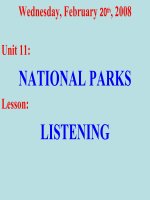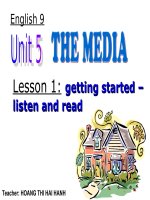Unit 5 products and innovation
Bạn đang xem bản rút gọn của tài liệu. Xem và tải ngay bản đầy đủ của tài liệu tại đây (118.37 KB, 11 trang )
Unit 5: PRODUCTS AND INNOVATION (các sản phẩm & sự đổi mới)
Lesson 1:
PRODUCT FEATURES (TÍNH NĂNG SP OR SP ĐẶC TRƯNG)
Asking about product features
When asking about a product in a store, you might first want to ask about its level of quality.
Top of the range
Middle of the range
Good value for money
A bud get option
You might also want to ask about the things that come with it.
Accessories (phụ kiện)
A strap ( cạm bẩy, mưu kế, lính cảnh sát)
Cables (cáp, dây cáp)
Instructions
A case
A charger ( bộ sạc)
Asking about a product
A shopper is asking about a tablet. How many accessories does it come with? Select the correct meaning
How many accessories does the tablet come with? Three
Inquiring about a product
Before you ask about a product, use an expression like this to get the sales assistant’s attention.
Excuse me. Can I just ask you something about this tablet?
You then might need to confirm what it is you’re looking at.
This is a Jupiter, is that right?
You might also want to know if the product is top odd the range or not?
And how does this compare with other tablets?
Finally, you might want to ask about the color, accessories and other extras.
Does it come in other colors?
Is it available with a keyboard?
Does it come with all the accessories?
Move the text to the correct gap
Can I just ask you something about this desk?
Is it available in a larger size?
Does it come with instructions so I know how to use it?
This one’s too expensive. Do you have a budget (ngân sách) option?
Does it come with any accessories, like a case or cables?
I want a middle-of-the-range model – not too expensive, not too cheap.
Making a purchase
The process of paying for a product can differ from country to country. Here are some things to be
aware of when buying something in the US.
Paying for purchase
Nowadays, few people write checks for their purchases (mua hàng). Cards and cash are quick
convenient. It’s important to understand that debit cards and credit cards are very different. When you
use a debit card. The money is taken directly from a bank account. When you use a credit card, you are
borrowing the money from a financial company and have to pay the money back in the future.
Taxes
Most states in the United States have a sales tax, money collected for the government. The sales tax is a
percentage of the purchase price.
Returning an item
When you buying something, ask about the store’s return policy, the rule for bringing back something
that you don’t want. There is usually a time limit for returns-for example, 30 days – and some items may
not be returnable. To return an item, you must have the receipt, the piece of paper that shows the price
and that you bought the item at that store. The store will usually give you a refund, the money you paid
for the item.
Listen to a customer make a purchase in a department store. Select the correct answer.
How much is the belt (thắt lưng)?
Move the text to the correct gap
M. Good morning.
C. Good morning. So, just this belt?
M. Yes, thanks, just the belt.
C. OK. With tax, that’s $67.93. How would you like to pay?
M. I’ll use my card.
C. Credit or debit?
M. Uh, credit card.
C. OK. Just slide your card.
M. OK
C. Please sign here.
M. Here you go.
C. And here’s your receipt. Have a wonderful day.
M. you, too. Oh, by the way, what’s your return policy?
C. You can return anything before 90days for a full refund. But keep your receipt.
M. Great. Thanks
Listen at the cash register
Listen for number when you make a purchase in a store. In the US, dollars (written as $) and cents
indicate the amount you owe.
That comes to $7.64
They may also shorten the amount to just the numbers.
With tax, your total is $495.75.
In the UK, listen for pounds (written as L) and pence (xu)
That’s L78.22
L321.21, please
You may also hear pence said in the same way as the letter p.
That’s 58p, please.
Listen for numbers with a time period like days or weeks when talking about a return policy.
You can return anything before 90 days for a full refund.
You can bring the item back within 30days
Listen to numbers with a percentage ( phần trăm) when talking about fabric.
The blouse is 100% cotton.
It’s 90% cashmere, 10% polyester.
Listening for numbers
Watch the video and answer the questions.
Nina. Kate’s great with customers.
Kate. Wow. Those trousers (quần jean, quần tây) look fabulous (tuyệt vời) on you.
The turquoise ( màu ngọc lam) one is, uh, 100 percent cotton.
They also come in navy (màu xanh hải quân)
Umm, and if you want, you know, you could team it… The hot-pink one is polyester blend ( hỗn hợp
polyester)
Ok, so that come to 255 pounds 98 pence. How would you like to pay?
When I got back from my buying trip, I looked at our sales figures.
And It turns out last week was our best week so far.
It’s a good job that I came back with lots of stuff to fill uo in the stockroom
Making a purchase
Before you make your purchase at a store, remember to talk about the return policy.
What’s your return policy?
You can return any item for a full refund within seven days. Remember to bring your receipt.
After totaling up your items, the cashier will tell you the how much you owe.
Your total with tax will be $477.25
That comes to $17.99
The cashier may ask you what form of payment you want to use.
How would you like to pay?
I’ll will use my debit card.
Will that b credit or debit?
Debit, please
If you’re paying with a card, the cashier will either ask for your card a slide it for you, or ask you to slide
it.
May I see your card, please?
Go ahead and slide your card. Then press “OK”
When you use a credit or debit card, sometimes you sign your name on paper or a machine, and the
cashier gives you a copy of the receipt. Sometimes you have to type in your card’s personal
identification number (PIN). When people hand you something in the transaction (giao dịch), they will
often use the word here.
Could you sign here, please?
Sure.
OK. Here’s your receipt. Have a nice day!
LESSON 3
WRITING ABOUT PRODUCT INNOVATION
Nouns, verb and adjectives
Watch the video and study the language
<Sally> Hey, Simon. Simon? Hello?
<Simon> Oh, hey.
You know, there’s a revolution (cuộc cách mạng) in technology going on.
Sa/ Yeah, I know.
Si/ Are we ready for it?
Sa/ We? You mean, IXW?
Si/ Yeah. People have had smartphones for years, but we haven’t developed one mobile application.
Sa/ I can see why you’re worried. I already do all my banking on my smartphone. If only I could do my
taxes on it.
Si/ I’m sure our competition is working on that. We should be, too. I have some concerns about our
company’s attitude toward mobile applications.
Sa/ Yeah, We’re in danger of falling behind.
Si/ We are falling behind. Some developer’s probably (có lẻ) already invented (phát minh) the next cool
app for banking. And they’re selling it to a competitor right now.
Sa/ Why don’t you talk to Todd and Joan about it?
Si/ Maybe I will. I have a meeting with them this afternoon.
Sa/ Do you think they’re concerned about mobile?
Si/ No yet. But after our discussion, they will be
Group the words according to whether they are verbs, nouns or adjectives. Use the word endings to
help you.
Move the words to the correct verb collocation.
Verb(-ize)
Noun(-ion)
adjective(- ary, -ive, - ed)
Revolutionize
Revolution
Revolutionary
Invent
Invention
Inventive
Produce
Production
Productive
Describe
Description
Descriptive
Magazine:
Multi-Drive
Plan your day.
Get your email.
Send texts.
Get organized while you're in your car.
Stop wasting time in your car. Multi-Drive, our latest hands-free invention, will
revolutionize the way you work – and get to work. Use any smartphone with the MultiDrive system. Now you can work safely and successfully outside your office. Want to
organize your schedule? Tell Multi-Drive. Need that important email from your boss?
Let Multi-Drive read it to you. Text messages? Speak and send them with Multi-Drive.
Be more productive. Go to work before you get to work!
Select the correct form of the words
Multi-Drive is a revolutionary new way to use your smartphone in your car.
Multi- Drive helps you be more productive on your way to work. You can prepare
reports, make appointments and text colleagues.
Todd Meacham created the Multi-Drive application. He’s one of our most inventive
developers.
Todd will now describe how Multi-Drive works. Todd?
Sorry, I’m not very organized. I can’t find my notes. Uh. Just a minute.
FUTURE CONTINUOUS
Frank thinks he’ll be designing skyscrapers someday
Oscar thinks someday robots will be helping humankind.
Future continuous
Use the future continuous tense to talk about an event that will last for a period of time in the future. Form the future contin
be and a verb + ing. Use it for talking about things you expect to happen.
People will be using their smartphones for everything.
They'll be producing smartphones that you can wear like a ring.
A: Will you still be working here in 20 years?
B: Yes, but I'll be running the company.
An inventor is talking about technology innovations on TV. Listen to Judy and Mac discuss what she
says.
Move the text to the correct gap.
INVENTOR: Everything is changing. Technology is revolutionizing our work and
entertainment.
JUDY: What's she talking about?
MAC: I'm not really sure. Something about how they'll soon be producing notebooks that
are as thin as a piece of paper?
JUDY: I'm not interested. I'm happy with my old desktop computer.
MAC: Shhh! Let's listen to what she's saying.
INVENTOR: No more monitors. We'll be using our hands, the wall, a desk – anything flat –
as a touch screen .
JUDY: Huh?
MAC: Wow. I think that she means we'll be taking anything flat and using it as a computer
monitor. Like, we could see a video game and a keyboard on a wall and press the keys to
play the game.
JUDY: Scary! I don't want to play a video game or call somebody on my hand.
MAC: But you will. Everyone will be doing it someday.
INVENTOR: Yes, ladies and gentlemen! This is the future.
EXPRESSING WORRIES AND CONCERNS
Expressing worries and concerns
Use the words worry and concern to talk about bad things that could happen
'Worry' and 'concern' with 'that'
Use that when the next part of the sentence is an independent clause (a phrase with a noun and a verb
that can stand alone as a sentence).
I'm worried that we'll fall behind the competition.
I'm concerned that we won't be able to compete.
'Worry' and 'concern' with 'about'
Use about when the next part of the sentence is a noun or a gerund (verb + ing). Notice that, in these
examples, concerned is an adjective and concerns is a noun.
I'm worried about the competition.
I'm concerned about losing so much money.
I have some serious concerns about the deal.
Another expression you can use to express concern is in danger of. In danger of is always followed by a
gerund or a gerund phrase.
We're in danger of falling behind the competition
Use the following questions to ask someone about their concerns.
What are you concerned about?
Are you worried that we'll fail?
To show sympathy with someone's worries, you can use this expression.
I can see why you're worried about that.
Two banking executives, Dan and Courtney, are talking about their concerns.
Move the text to the correct gap.
DAN: You look worried.
COURTNEY: I am. I'm very worried.
DAN: What are you worried about ?
COURTNEY: I'm concerned that we don't offer a mobile banking application.
DAN: I can see why you're concerned . All the other banks in the area have one.
COURTNEY: I know. I'm worried that we're falling behind them. It's driving me crazy.
DAN: Yeah. So many problems. I'm also worried that the online banking product isn't doing
very well.
COURTNEY: What do you mean?
DAN: Well, I have some serious concerns about design. Our online banking product looks
like it was made in 1990.
Writing about future concerns
You're going to write an email about some future concerns for your company. Think about
challenges your company faces, or general problems companies face. Write an email to the boss
describing two challenges and solutions.
Type in the input box. Write 75-130 words. Use your own words where possible.
We take your privacy seriously. Please don’t share any personal information (race, religion, health
status, etc.) about yourself.
Hi, Song.
In the meeting on Monday, we talked about our future strategy, and I have some comments I’d like to
share.
First, there’s a lot of competition in our services, and I think we’re in danger of falling behind. Our
competitor is working on a revolutionary new mobile app. We’ll need to invest more in our research and
development departments in order to compete.
There’s one other thing I wanted to mention. We’ll be bringing in 20 new members to our marketing
department. I have some com concerns about the training sessions because it’s such a large group. If we
can, we should get Patty to do the training. She did a great job with the new recruits last year.
Let me know what you think.
Best regard,
Jendy
Lesson 4: INNOVATIVE (ĐỔI MỚI) THINKING
Describing effects
Here are some phrases you can use to describe the effects of actions.
It made a lot of people feel very worried about in the future of the company
It had quite a bad effect on staff morale (tinh thần nhân viên)
It caused several people to quit. Nó khiến một số người bỏ cuộc.
The result was that we started to think differently about our customers.
Giving background information
You can use the past perfect- had + past participle – to give a sense of what happened previous to a
story you are telling.
We had lost a lot of money the first year, and nothing we’d tried to do had made any difference.
If you want to indicate (biểu thị chỉ ra) that the action had been going on for an extended period, use the
continuous form: had + been + verb+ ing
Well, we’d been struggling (đấu tranh) to innovate for a while.
We’d been trying to solve the problem for months, and nothing had workedBac
Background information
Move the text to the correct gap
We found a solution to a problem that had been frustrating us for a while
It was great when we moved in, because we had been looking for a new office for a while.
We’d had problems with the new manager, but they were later resolved.
We’d been trying to work out what to do for a while, and when the answer came, it was a surprise.
I had met him years ago, but we didn’t work together until this year.
Solutions
It’s another job interview, and another discussion about innovation. Select the correct answer
Describing solutions
Here are some phrases you can use when you’re describing solutions.
We dealt with the problem by hiring more creative people.
Well, the way we got around the issue was to reduce the length of the meetings.
And that solved the problem?
Yes. It was an effective solution, and I was pleased with it









